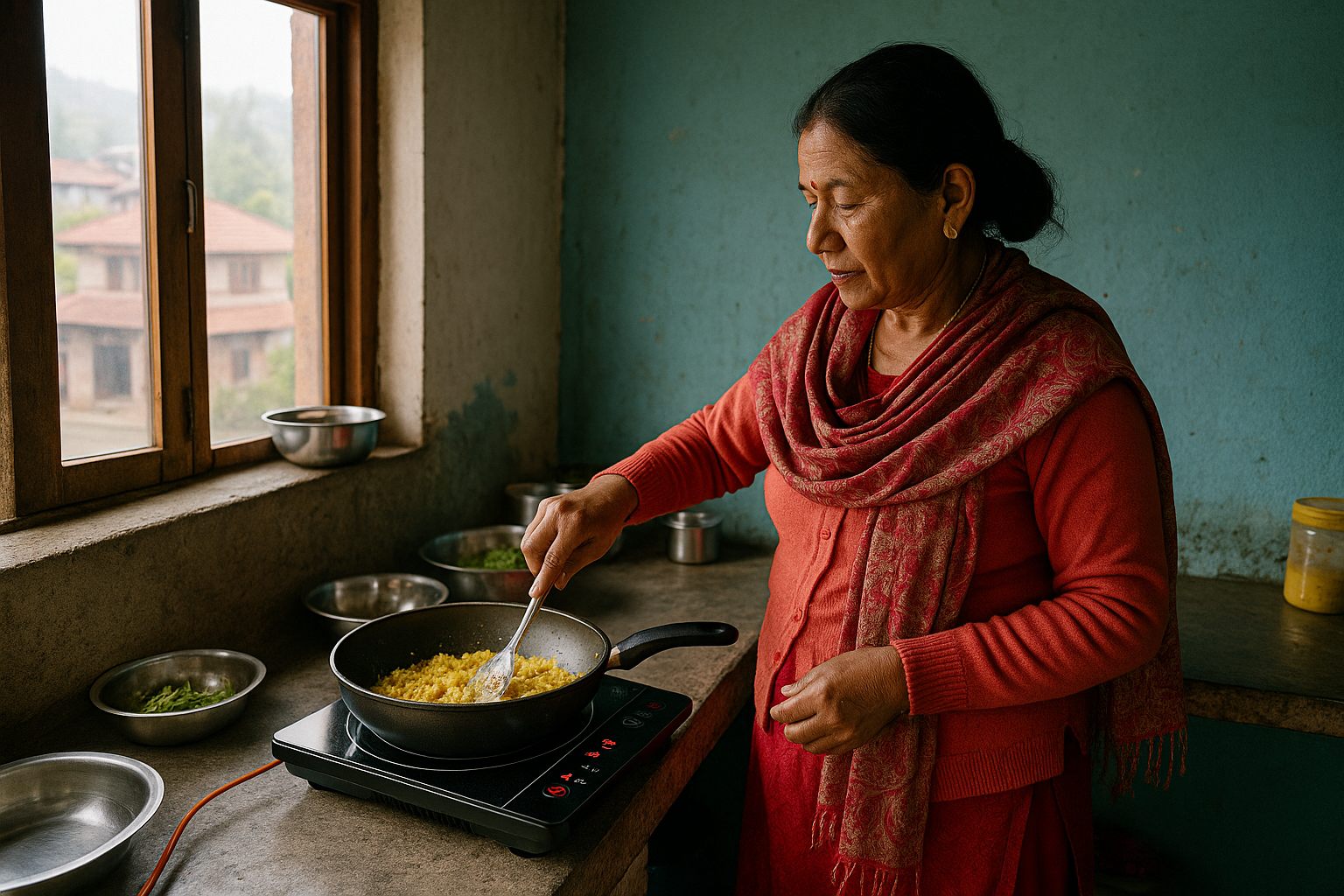Nepal’s Cooking Revolution: How Electricity Can Replace LPG and Biomass Fuels
A World Bank study finds that switching from biomass and LPG to electric cooking in Nepal is economically beneficial, environmentally cleaner, and healthier for households. With policy support and infrastructure improvements, electric cooking could significantly reduce health costs and fuel imports.

A recent study by Sunil Malla, Govinda R. Timilsina, and Martin P. Heger, supported by the World Bank’s Development Research Group and the South Asia Department for Environment and Blue Economy, presents a sweeping economic and environmental evaluation of household cooking practices in Nepal. Despite Nepal’s significant progress in electrification, the study reveals that cooking in most households remains rooted in traditional, polluting biomass fuels like firewood, dung, and crop residue. These fuels are not only inefficient and unhealthy but also responsible for thousands of premature deaths annually. While LPG has gained ground in urban areas as a cleaner alternative, its economic burden is severe due to Nepal’s total dependence on imports. Meanwhile, electricity, largely generated from clean, domestic hydropower, remains a vastly underused resource for cooking, accounting for less than one percent of household fuel use.
Fuelwood Dominance: Cheap But Costly
The study highlights a paradox in Nepal’s household energy use: fuelwood, although economically attractive to households due to its free availability in rural areas, exacts a heavy toll in terms of public health and environmental degradation. More than 50% of households still rely on biomass as their primary cooking fuel, with this figure exceeding 80% in remote western provinces like Karnali and Sudurpachim. In terms of private cost, traditional cookstoves using fuelwood are virtually free if households gather wood themselves. However, once health-related costs and environmental impacts are accounted for, especially emissions of PM2.5, a deadly air pollutant, the economic equation changes dramatically. The study finds that rural households using traditional stoves can emit over 5 kilograms of PM2.5 annually, contributing to respiratory diseases, chronic illnesses, and early deaths. In 2019, indoor air pollution led to over 25,000 deaths in Nepal, with associated economic losses estimated at NRs 39.8 billion, nearly 1% of the country’s GDP.
Electric Cooking: Economical and Emission-Free
Electricity emerges from the study as a surprisingly competitive cooking fuel when compared with LPG and kerosene. Using a Levelized Cost of Cooking (LCOC) framework, the researchers compare cooking costs across different technologies and fuels, taking into account device efficiency, capital investment, maintenance, and local fuel prices. While LPG use has skyrocketed in urban areas, it remains more expensive than electric cooking when assessed purely on cost per household. For instance, average annual cooking costs using LPG are around NRs 26,700, while electric pressure cookers and induction stoves can reduce this to between NRs 9,000 and 17,000. Moreover, electricity offers near-zero emissions at the point of use, eliminating household air pollution and reducing the risk of health complications.
The main reasons for electric cooking’s low adoption are not economic but infrastructural and behavioral. Inconsistent electricity supply, high upfront costs for electric stoves, and deeply rooted cooking habits discourage households from transitioning. Still, the study suggests that with strategic policy interventions, like subsidies, installment-based appliance purchases, and awareness campaigns, electric cooking can scale significantly.
The LPG Trade Trap and Hydropower Opportunity
LPG consumption in Nepal has grown exponentially, especially in cities where it is seen as a cleaner and faster alternative to biomass. However, this comes at a steep cost: Nepal spent over NRs 55.6 billion on LPG imports in FY 2023/24, accounting for 3.5% of its total import bill. In contrast, Nepal’s electricity supply, primarily sourced from domestic hydropower, is surplus during the wet season and could be directed toward household cooking if demand were properly stimulated.
The report lays out a hypothetical but plausible macroeconomic scenario in which all residential LPG use in 2023 is replaced with electricity. This would require the installation of 1,145 MW of new hydropower capacity and an investment of about US$2.86 billion. However, the payoff would be enormous: 14,600 construction jobs per year over five years, 2,000 permanent jobs for plant operation, and annual value-added contributions of US$157 million during construction and US$124 million during operation. These benefits would ripple across the economy and reduce Nepal’s dependence on foreign fuel, thereby easing the trade deficit with India.
Policy Directions: Making the Switch Possible
The study concludes with several practical policy recommendations aimed at accelerating the transition to electric cooking. First, Nepal should promote local manufacturing and repair markets for electric cookstoves to lower appliance costs. Second, flexible payment models and targeted subsidies could help low-income households absorb the initial cost of switching. Third, public awareness campaigns should emphasize not only the cost savings but also the significant health benefits of electric cooking. Finally, and most critically, improvements in electricity reliability and distribution infrastructure must accompany demand-side incentives.
With over 94% of households connected to the electricity grid, Nepal is uniquely positioned to lead a clean cooking revolution powered by its abundant hydropower. As the study demonstrates, electric cooking is not only viable but preferable, economically, environmentally, and socially. By redirecting subsidies from LPG to electricity, investing in infrastructure, and promoting behavioral change, Nepal can significantly reduce pollution-related deaths, cut its fuel import bill, and stimulate economic growth. In short, the kitchen could become a cornerstone of Nepal’s sustainable development strategy.
- FIRST PUBLISHED IN:
- Devdiscourse
ALSO READ
AI for All? World Bank Lays Out Roadmap to Help Developing Nations Catch Up
Tragic Collision in Nepal: Indian National Killed, Another Injured
Iraqi National Arrested Attempting Illegal Nepal Crossing
Nepalese Citizens Rescued from Captivity in Uttarakhand
Nepali Youths Rescued from Job Scam in India










